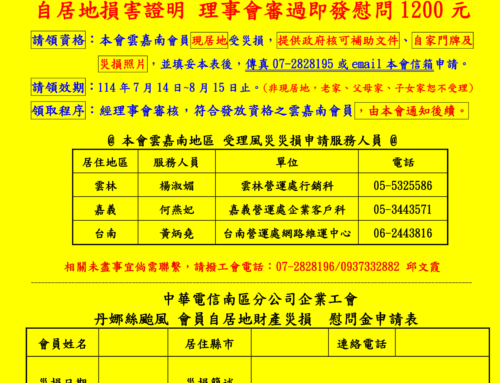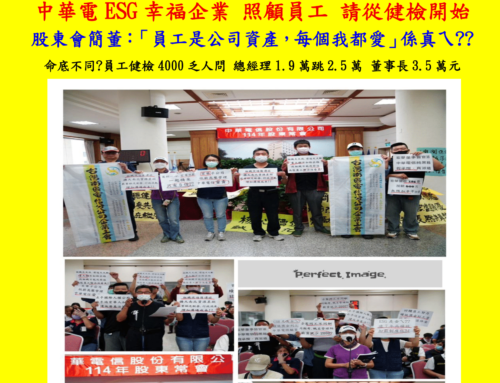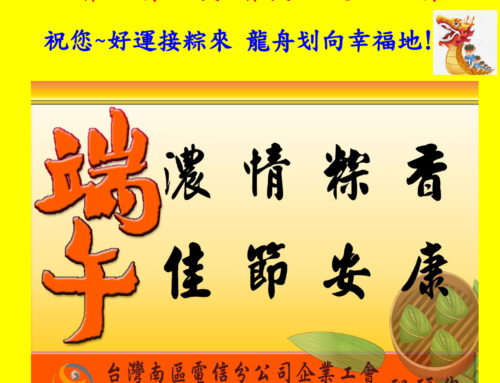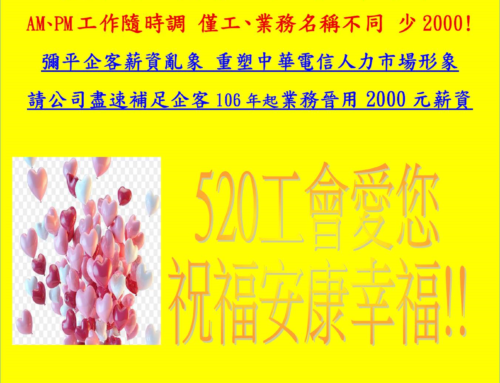

When small is powerful – journey of CHT Southern Business Group Workers’ Union
Prof. Santanu Sarkar
Visiting Scholar (ILR, National Chengchi University, Taipei)
Professor of Labour Relations (XLRI Jamshedpur, India)
email: [email protected]
Chunghwa Telecom Taiwan Southern Business Group Workers’ Union (or TSWU) is a name, which labour researchers and labour rights activists or lawyers in Taiwan may not be conversant. TSWU was founded in 2005 and the formation did not drew attention of the media or public. Chunghwa Telecom Co. (CHT), which is apparently the largest telecom provider in Taiwan, has 21 branches in the country. Hsu-Chung Chang (Chang, henceforth), the then President of Chunghwa Telecom Workers’ Union (CTWU) urged, and if needed, emboldened CHT’s branches to form its own union, which can function independently and remain autonomous in its own county.
According to Chang, if CTWU, which at a point of time was the largest labor organization in Taiwan with close to 200,000 members, has to develop the union into a strong labour organization and exercise union power then it must depend on collective strength of employees working in every branch of the company in every county of the country. CTWU under Chang’s leadership believes in paying adequate attention to respective local unions’ functioning to affirm independence that local unions should exercise in performing tasks at its own level. Per Chang, the CTWU as a union should have lesser control over the branch unions. Therefore, he persuaded every branch union to get it registered with the respective county and start functioning as an autonomous union free from the control of the government machinery. The CTWU progressively functioned as a federation of 21 autonomous branch unions under Chang’s stewardship.
Chang comes from the city of Kaohsiung in South Taiwan. While being in the position of President of CTWU, he registered the Kaohsiung City CTWU [or “A”] in 2005 to be the branch union associated with Kaohsiung county. It mostly operated as an independent union from the beginning. Though CTWU existed at that point of time and was obviously the most active union among all and operating full-fledged, still the employees of CHT from Kaohsiung city along their membership with the CTWU decided to join for the furtherance of the objective of “A”. This was one of the outcomes of the process driven exclusively by Chang while he was the President of CTWU back in mid-2000.
In 2013, when Chang finished his PhD in public administration from the Sun-Yet Sen University, his close associates pressed him to contest in election for the President position of the CTWU once again. Instead of contesting (as he was already elected as President for two consecutive terms), Chang decided to reorganize “A”. It could be a calculated move or Chang exercised the only option with him since there was a stiff resistance from a fraction of the CTWU towards his becoming President for the third consecutive time. Majority from the fraction were maintaining their allegiance to one of the two major parties in democratic Taiwan’s political milieu.
At first, Chang changed the name of “A” to CHT Southern Business Group Workers’ Union (TSWU). He could do this as there was fortunately a legislative reform brought by the then government in 2011. The then government revised the Trade Union Law. It is seen as an important milestone in the country’s labour movement. It was for the first time since 1949 when ruling Kuomintang took the much-needed initiative to revise the archaic labour laws. As per this revision, the government agreed and allowed one enterprise to have more than one union. And, that is how TSWU legally coexisted with the CTWU since 2011. In earlier days, the labor law had laid down provision under which one company can have only one union. However, per Chang, when the Trade Union Law was revised in 2011, government allowed companies that have multiple branches / factories / establishments / units in one or more counties to have separate union representing the branches / factories / establishments / units.
Therefore, today other big SOEs too have more than one union. For instance, Taiwan Petroleum has more than one union and likewise the Tai-Power has many unions that have formed with time.
This first initiative by the government undoubtedly caused multiplicity of union, thus encouraging pluralism in labour movement. However, it has also offered respite to those who wanted to breathe fresh air by moving out of the clutches of the state sponsored SOE unions.
When the TSWU was formed in 2005, those employees from the Kaohsiung country who decided to take membership of TSWU alongside their membership with CTWU, not of them was a due paying member on record because legally the TSWU could not collect membership fee. The existing law did not allow an enterprise to have more than one union. So, in 2013 when close to 1000 members of the TSWU started paying their dues, it was a big boost to the union. “Though small in size, our significance will quickly grow in Taiwan’s labour movement when more due paying members will decide to join TSWU over CTWU by rebutting dual membership as they will enjoy greater freedom and gain more benefits from the CBA”, avows Chang.
CHT has 11 unions in 21 counties. However, two unions hold true organizing and bargaining power. Only the CTWU (the parent union) and the TSWU (initially a branch union and now an independent union) could proof their metal. Remaining nine are apparently paper tigers who chose to stay dormant and remain aloof on most occasions. Consequently, they have never succeeded in signing a single agreement to say the least with the CHT.
Chang adds that the CTWU, at one point of time was the largest industrial union in Taiwan and today it has note more than 20,000 members only whereas other large SOE unions like the Tai-Power Workers’ Union still has more than 26,000 members. CHT has signed collective bargaining agreements with both CTWU and TSWU. In 2006, the CTWU under the leadership of Chang successfully signed a CBA with CHT and in 2014, Chang signed post amendment in the Trade Union Law, the second CBA with the CHT while he was representing TSWU. The CBA of 2014 is applicable to every member of the TSWU. Chang takes the credit of signing two separate CBAs with the CHT representing two different unions at two different points of time.
Chang opines that it is good to have ‘one-company-one-union’ policy like firms from Nordic countries follow until the time the only union maintains an independent position, free from employer’s interference and the government’s control. This is relevant given the fact that larger SOE unions in Taiwan were largely influenced and controlled by the ruling party.
As an evidence of growing independence among unionized workforce in Taiwan, Chang adds that old unions in most SOEs are reorganizing themselves. They are keen to change their name from ‘China’ to ‘Taiwan’. Over the past few years, China Postal, China Power, China Railway, or China Ship Building Corporation Workers’ Union changed their names to Taiwan Postal, Taiwan Power, Taiwan Railway, or Taiwan Ship Building Corporation Workers’ Union. Chang says, “One may say that they were influenced by the Minchintang’s political stand on independence of Taiwan over unification with China. But, one has to believe that for an average Taiwanese worker who comes across a union with the word ‘Taiwan’ in its name, then it is highly likely that he will perceive the union to be an independent union”.
On the question of how decentralizing the union power benefits labor movement, Chang believes that the SOE unions are more or less under the control of government. However, no party stays in power for more than two consecutive terms in Taiwan. Above all these, the lawmakers in 2011 allowed one company to have more than one union. Today, most big unions are still the SOE unions who are more or less under the control and influence of the ruling party. As a result, soon after the new law was passed in 2011, SOE union members in large number wanted to free themselves from the control of government. Smaller independent unions started forming. Many were splinter groups of large SOE unions. Chang strongly believes that if these smaller unions with time grow and can consolidate it can become a part of bigger independent labour movement.
The whole process will certainly take time, adds Chang. “May be over a period of time these smaller unions will organize a confederation of unions”, hopes Chang. Chang’s theory offers an exciting account of how independent union like TSWU is born and survives in modern day. Since government allowed one company to have legally multiple unions, a number of splinter groups was formed and they moved out of SOE unions, formed independent unions with different names and most important of all succeeded in maintaining separate membership base. Chang firmly believes that with time SOE unions will not remain the larger unions as members will leave them and soon join the confederation of independent unions in Taiwan.





